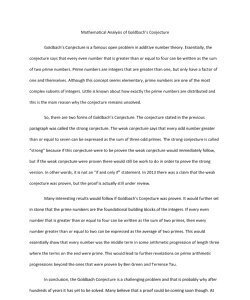Mathematical Analysis of Goldbach’s Conjecture Goldbach’s Conjecture is a famous open problem in additive number theory. Essentially, the conjecture says that every even number that is
Mathematical Analysis of Goldbach’s Conjecture Goldbach’s Conjecture is a famous open problem in additive number theory. Essentially, the conjecture says that every even number that is
Mathematical Analysis of Goldbach’s Conjecture
Goldbach’s Conjecture is a famous open problem in additive number theory. Essentially, the conjecture says that every even number that is greater than or equal to four can be written as the sum of two prime numbers. Prime numbers are integers that are greater than one, but only have a factor of one and themselves. Although this concept seems elementary, prime numbers are one of the most complex subsets of integers. Little is known about how exactly the prime numbers are distributed and this is the main reason why the conjecture remains unsolved.
So, there are two forms of Goldbach’s Conjecture. The conjecture stated in the previous paragraph was called the strong conjecture. The weak conjecture says that every odd number greater than or equal to seven can be expressed as the sum of three odd primes. The strong conjecture is called “strong” because if this conjecture were to be proven the weak conjecture would immediately follow, but if the weak conjecture were proven there would still be work to do in order to prove the strong version. In other words, it is not an “if and only if” statement. In 2013 there was a claim that the weak conjecture was proven, but the proof is actually still under review.
